Browse using the new Vinous website now. Launch →
Printed by, and for the sole use of . All rights reserved © 2015 Vinous Media
Santa Barbara: Out of Many, One
BY BILLY NORRIS | AUGUST 28, 2025
The refrain that kept running through my head over the course of two weeks of extensive tasting in and around Santa Barbara County was, “Is there anywhere else in the world that can do this many things this well?” The tapestry that makes up the Santa Barbara wine landscape is easily one of the most dynamic in the United States, if not the world. It’s also the very thing that unites an otherwise complicated region. Through the lens of a long, auspicious growing season in 2023, Santa Barbara yielded an embarrassment of riches.
A Primer
The Santa Barbara winegrowing region centers around a diverse geologic makeup articulated by the Transverse Ranges. Whereas California’s mountain ranges generally trend parallel to the coast, the Transverse Ranges run perpendicular to the coast, terminating at the Pacific Ocean. These mountains sit at a kink in the San Andreas system, where the Earth’s crust was crumpled and twisted over tens of millions of years. That uplift and faulting hauled a kaleidoscopic array of rocks to the surface—sandstones, shales and the chalky, diatomaceous layers of the Monterey Formation—then rivers and wind re-sorted them across the valleys. The result is a tight patchwork of calcareous clays, sandy loams, diatomaceous earth and gravel within short distances. This is fertile ground for terroir-driven wines.
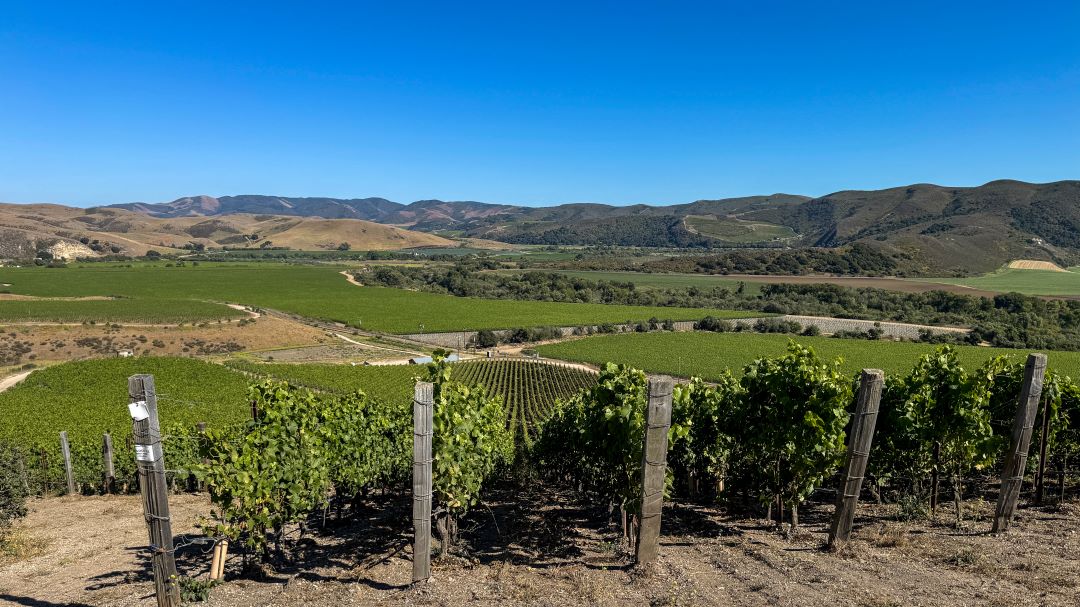
Domaine de la Côte’s La Côte vineyard at the far western edge of the Sta. Rita Hills.
Vineyards are sandwiched between the San Rafael Mountains to the north and the Santa Ynez Mountains to the south. As the areas further inland gradually warm during the day, the resulting pressure gradient pulls vigorous ocean-chilled wind and fog in from the Pacific, mitigating overall temperatures and blanketing the area in damp, cool conditions. This pattern preserves acidity and often yields small berries with thick skins, especially in the coolest, windiest sites to the west. Warmer sites in the eastern portions of the region see more direct sunlight and less of the ocean influence.
Though grapegrowing and winemaking in Santa Barbara County date back to the Mission era of the late 1700s and early 1800s, the modern story began in 1962 with Pierre Lafond’s Santa Barbara Winery, the first post-Prohibition commercial winery in the county. Nielson Vineyard was the region’s first commercial vineyard, planted in 1964 in the Santa Maria Valley. Plantings began to expand southwestward from the Santa Maria Valley, but it wasn’t until 1971 that Richard Sanford and Michael Benedict settled on the now-Sta. Rita Hills for their risky, marginal-climate hedge. Though the original plantings of Cabernet Sauvignon and Riesling quickly proved too lean and mean, Pinot Noir and Chardonnay soon showed their mettle. Sanford & Benedict Vineyard was the proof-of-concept for the entire region—the spark that eventually kicked off a proliferation of new investment across Santa Barbara County. Vineyards began to pop up all over the Santa Ynez and Santa Maria Valleys.
The Magnificent Seven
Today, Santa Barbara County contains seven American Viticultural Areas (AVAs). The Santa Maria Valley was the first to be recognized, officially designated in 1981. It’s home to the legendary Bien Nacido Vineyard, where Pinot Noir, Chardonnay and Rhône varieties perform very well. However, the glut of fog tends to build up and settle here, creating all sorts of fungal disease pressure that makes ripening grapes an uphill battle in many seasons. The Santa Ynez Valley garnered official recognition in 1983. Eventually, it became both a parent AVA for nested subregions and a sort of catch-all for ‘everything that’s not in one of the other AVAs.’ Richard Sanford, Wes Hagen, Bryan Babcock, Greg and Brent Brewer, Peter Cargasacchi, Rick Longoria, Dan Gainey, Eli Parker and a number of other producers spearheaded the petition for the Sta. Rita Hills AVA in the late 1990s, which saw approval in 2001. This cold, westernmost AVA is the most exposed to the Pacific influence. It’s Pinot Noir and Chardonnay dreamland, but Sine Qua Non’s Manfred and Elaine Krankl believed that Rhône varieties had a future there, planting their Eleven Confessions estate vineyard with primarily Syrah and Grenache in 2001. Judging by the significant number of estates that have since begun to focus on Rhône varieties in the Sta. Rita Hills, it appears the Krankls were ahead of their time. Happy Canyon of Santa Barbara, a fertile landscape for Bordeaux varieties at the far eastern edge of the Santa Ynez Valley, followed in 2009. The bucolic Rhône variety paradise that is Ballard Canyon came in 2013, Los Olivos District in 2016 and the newest, Alisos Canyon in 2020.
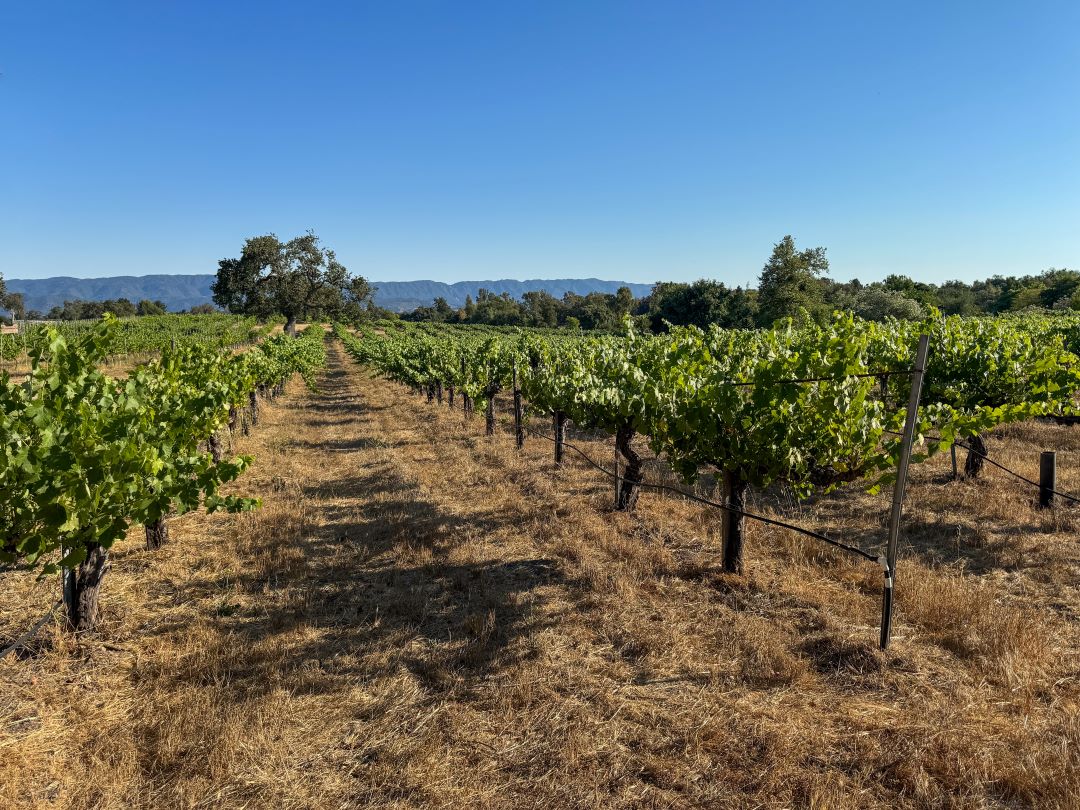
Ibarra-Young Vineyard in the Los Olivos District, currently under long-term lease by Alice Anderson and Topher De Felice of Âmevive.
The Brilliant 2023 Vintage – A Blessed Respite
The 2022 vintage was a punisher. Though many producers crafted very good wines, very few escaped completely unscathed. Accumulated drought conditions, extremely low yields and an extended, severe heatwave around Labor Day that generally timed out with Pinot Noir harvest made for both physical and logistical hurdles. The 2022s, especially Pinot Noirs, are inconsistent. There’s just no getting around it.
The tale of the 2023 growing season is much the same as it is elsewhere in California: late, cool, even and long. Things got off to a wet start, replenishing soil reserves with record rainfall and leading to a delayed, very long flowering, notably advantageous for Pinot Noir. A generous, though not extreme, fruit set paved the way for a return to more ‘normal’ yields. “We had 34 inches of rain, most of which fell in January, February and March, so we were able to dry farm,” said Winemaker Trey Fletcher at Sanford Winery. Our Lady of Guadalupe Vineyard Manager Amy Whiteford offered, “All that winter rain had the vines tucked in a nice little slumber. They took their time waking up and just got to relax all the way through the season.”
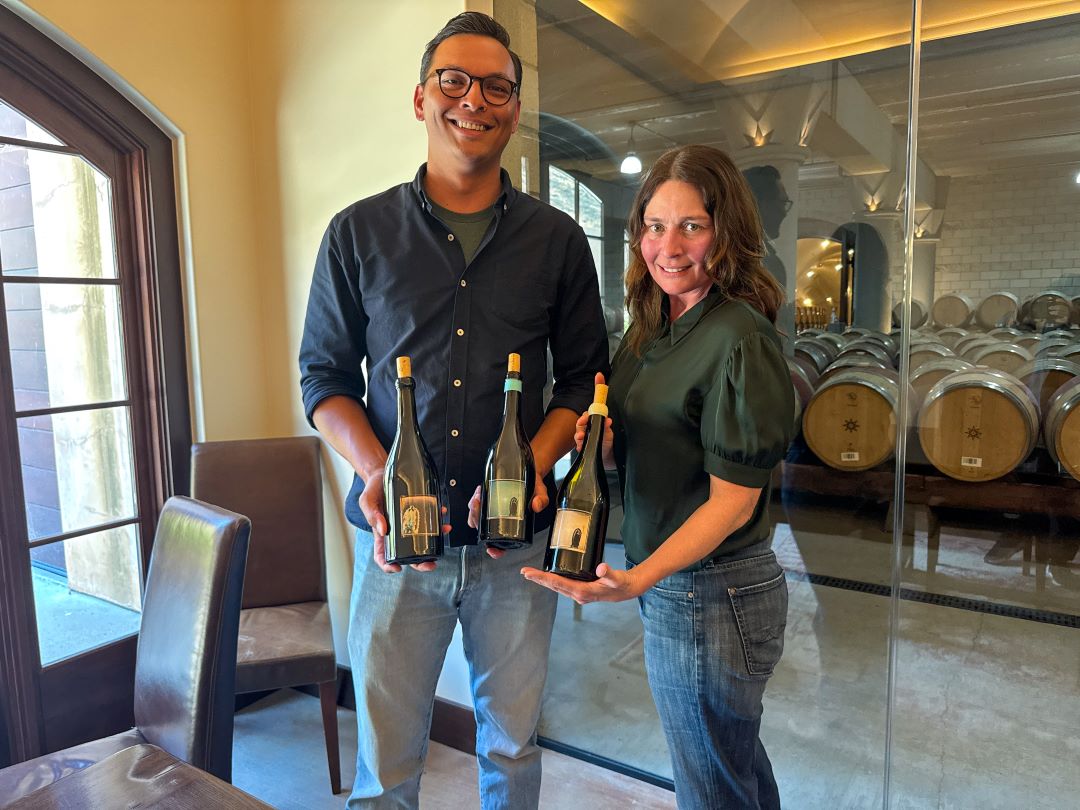
Assistant Winemaker Christopher Hussey and Vineyard Manager Amy Whiteford of Our Lady of Guadalupe.
Moderate temperatures prevailed through spring and summer, with a slow run-up to harvest and very gradual, measured sugar accumulation. For most, harvest commenced a full month later than in 2022, the latest many producers had experienced since 2011, if not ever. Gentle heatwaves (though that’s a very relative term considering the scorching temperatures of the year prior) settled in during late September and early October, but these served to gently coax fruit to ideal ripeness rather than beating it into submission.
“Two thousand twenty-three was the first time in our history that all of our Pinot Noir came in during the month of October,” said Adam Tolmach of Ojai Vineyard, who typically picks on the early side. Even in the warmer corner of Happy Canyon, Crown Point’s Simon Faury reported, “It was our first time ever picking Sauvignon Blanc in September.” Greg Brewer of Brewer-Clifton noted that they harvested Syrah from Perilune on November 14, and Andrew Murray experienced similarly late dates, noting, “In 2023, we didn’t finish until almost December. The vines just kept chugging along.”
Taken together, these long hangtimes allowed for flavor concentration at lower Brix levels, lower potential alcohols and “freaky-deaky high acidities” (according to The Hilt’s Matt Dees), a recipe for greatness in this cool-climate mecca. Late harvests also made for cooler ambient cellar temperatures, which means longer, slower fermentations and ultimately more depth of flavor. Win-win.

Dragonette winemaker Brandon Sparks-Gillis and his impressive quartet of 2023s from Radian and Bentrock in the Sta. Rita Hills.
That said, it wasn’t all rainbows and fairytales. The mildew monster was at large in 2023. Dees explained, “It was such a mild summer that the temperatures and conditions were perfect for our little fungal friend to linger and threaten the crop late into the vintage. It was the worst we had seen since 2008.” Dragonette’s Brandon Sparks-Gillis explained further, “Mildew thrives between 70-85°F, and you need 12 hours at 95°F to really burn it out. So, canopies in the Sta. Rita Hills are basically in the sweet spot for mildew all summer long, almost every year. In 2023, the cool temps and long growing season made that risk more challenging than usual. Organically farmed sites are the most at risk. Sprays had to be well timed, and frankly, we had to spray a lot. It wasn't just organic or biodynamic vineyards that were hit. We heard reports from friends who lost entire blocks to mildew even at conventionally farmed sites.”
Making wine in Santa Barbara—particularly the Sta. Rita Hills—is an extreme sport, even in the best of times.
The Wines
The 2023s from Santa Barbara are spectacular. The Chardonnays are tightly coiled and driven but extremely expressive, texturally layered and vibrant. Sites from the Sta. Rita Hills to the Santa Maria Valley turned out wines of compelling transparency, site character and, maybe most importantly, sheer enjoyability. Some of these, including Dragonette’s Chardonnay Bentrock Vineyard and The Hilt’s Chardonnay Vanguard, are among the very best Chardonnays I’ve tasted in California. Period.
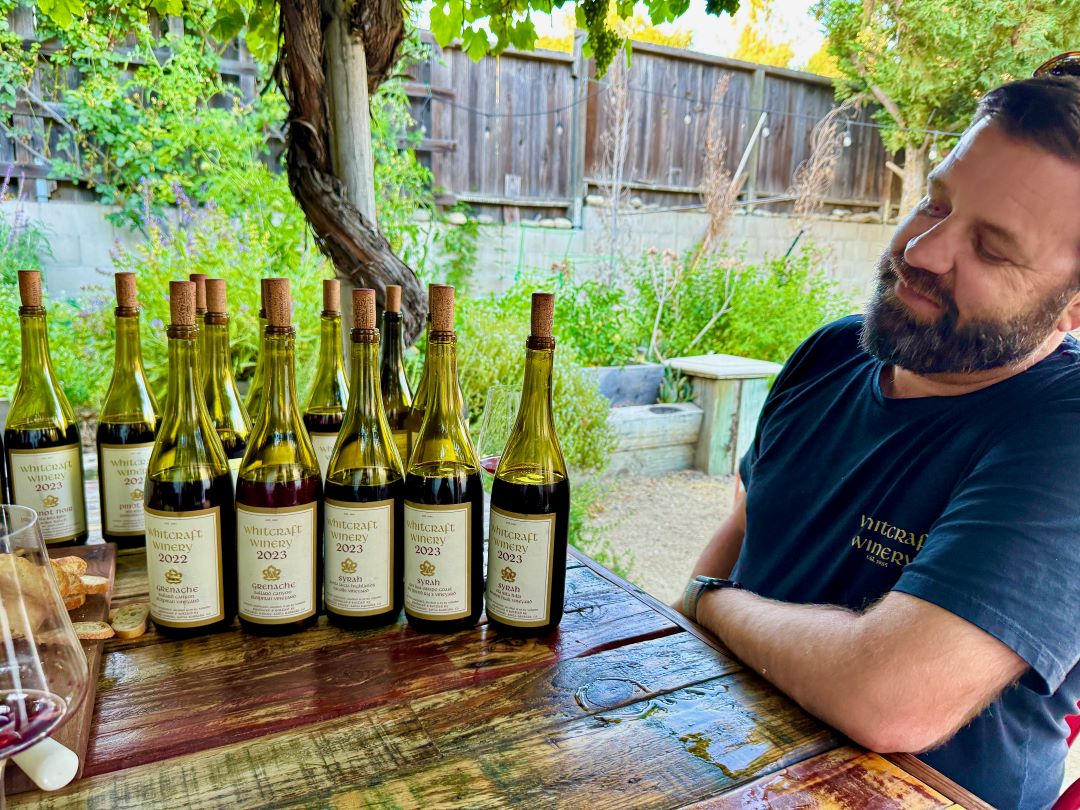
Drake Whitcraft’s wines show stunning purity and site signature from top to bottom.
Pinot Noirs are aromatic, lifted and seriously complex. Many of these wines are a touch lighter in build, but that’s only with regard to body, not palate presence or character. Many of the 2023 Pinot Noirs are intensely concentrated yet weightless, the platonic ideal of balance. The 2023s display notable textural polish, generous acidity and firm yet pliant tannins, all in elegant proportion. Whitcraft Winery’s 2023 Pinot Noir Radian Vineyard and Domaine de la Côte’s Pinot Noir Sous le Chêne are both truly memorable. For both Chardonnay and Pinot Noir, the wines from the far west of the Sta. Rita Hills (namely Bentrock, Radian and Domaine de la Côte) reached the highest heights in the hands of many producers, signs that point to true Grand Cru terroir.
Rhône varieties are similarly exceptional in 2023. Ballard Canyon brought the magic. The whole range of Stolpman’s The Great Places Syrahs, propagated from cuttings from some of the most hallowed sites in the Northern Rhône, vibrate in the glass with crystalline purity and boundless energy. These wines set a new benchmark for what Syrah can achieve here. Jonata’s Ballard Canyon estate turned out Rhône- and Bordeaux-style wines of sheer power and incredible mid-palate density without a shred of excess.

Pete Stolpman in the mother block of The Great Places Syrah at his family’s Ballard Canyon estate.
2024: Back-to-Back?
The 2024 vintage saw a return of hot weather—nothing extreme, but considerably warmer than 2023. But these are conditions that winemakers are getting very good at handling. To say that early tastings of 2024s have been encouraging would be an understatement. First and foremost, 2024 is a great Sauvignon Blanc vintage. Wines I tasted from Happy Canyon showed so much verve and character, with an added measure of ripeness and body. Domestic Sauvignon Blanc is rarely this exciting. Pinot Noir bottlings from William Hines and barrel samples from Domaine de la Côte (both from Sashi Moorman’s hands) point to a richer, more concentrated vintage that dials everything up a notch in an undeniably attractive way. Barrel tastings of Syrah from Tensley and early bottlings from Stolpman are potently concentrated and, once again, alive in the glass. Unfortunately for some producers in the Santa Ynez Valley, 2024’s Lake Fire socked the area in with smoke in July, compromising entire crops for some estates. Can Santa Barbara go back-to-back in 2023-2024? It’s too soon to tell, but I’ll take the over.
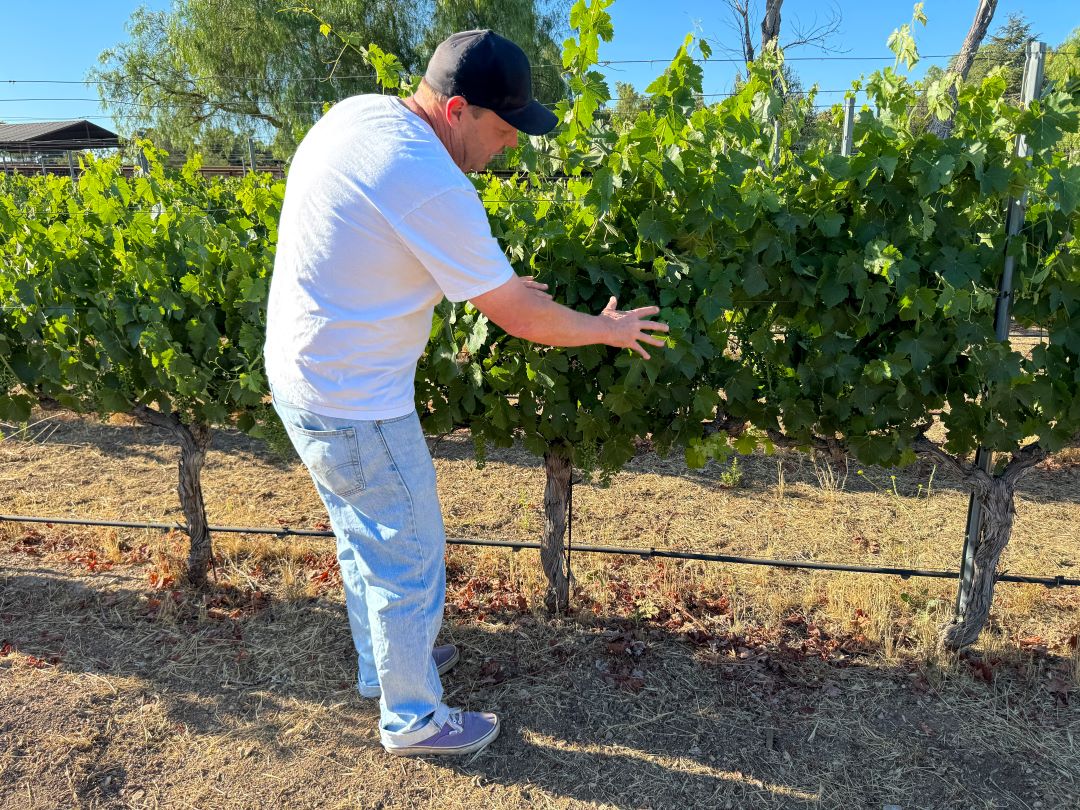
Joey Tensley in his eponymous vineyard, which happens to be in his backyard.
Headwinds
California vineyards typically enjoy about a 30-year productive life cycle before yields dwindle and replanting becomes inevitable, but a not-insignificant number of Santa Barbara vineyards are now well beyond that window and have begun to decline. Augmented by uncertain market conditions and the stubborn persistence of vine disease, several important sites have slipped into an uneasy grey area. Large swathes of historic blocks at Bien Nacido are being torn out every year, and Solomon Hills has been uprooted completely. Replanting remains a question mark for both. In the Sta. Rita Hills, John Sebastiano is being reconfigured, and Perilune’s future is similarly uncertain. These are not the only cases. How producers choose to deal with these challenges will only become clear over time.
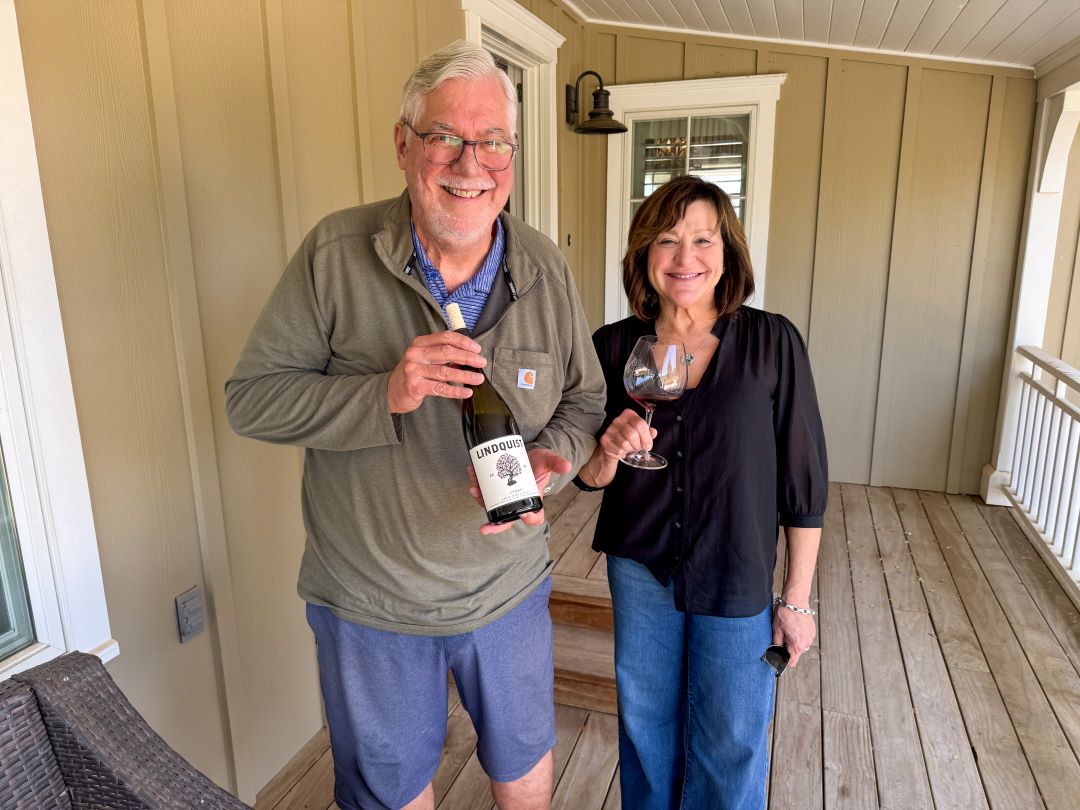
The end of an era. Bob Lindquist and Louisa Sawyer Lindquist, with their final bottling of Syrah from a now-uprooted parcel in Bien Nacido X-Block that Bob has worked with since his Qupé days in the 1980s.
A World of Its Own
With all that said, there is an undeniable spirit that runs through Santa Barbara. From the most humble, upstart producers to the most lauded cult projects, a through-line of passion, possibility and unshakeable optimism infuses the region with real hope. Santa Barbara’s greatest asset is its plurality. Its subregions each carry a vivid identity, and together they resist a tidy headline. Do they need one? I’m not convinced. The message is simpler: There’s genuinely something for everyone, at prices consumers can actually afford. It’s a one-stop shop.
I tasted the wines for this report in Santa Barbara County in July 2025. I’ve also included producers from neighboring regions, including San Luis Obispo County and Ventura County, whose wines share similar cool-climate sensibilities and deserve to be in the same conversation.
© 2025, Vinous. No portion of this article may be copied, shared or redistributed without prior consent from Vinous. Doing so is not only a violation of our copyright but also threatens the survival of independent wine criticism.
You Might Also Enjoy
Santa Barbara: California’s Undiscovered Jewel, Antonio Galloni, August 2024
Brilliance in Santa Barbara, Antonio Galloni, September 2023
Santa Barbara: A Rare Bright Spot for California in 2020, Antonio Galloni, August 2022
Santa Barbara: On the Road...Finally!, Antonio Galloni, October 2021
Show all the wines (sorted by score)
- 10 Ninths
- Addendum by Fess Parker
- Ad Ripa
- Alban Vineyards
- Alma Rosa Winery
- Âmevive
- Andrew Murray Vineyards
- A Tribute to Grace
- Au Bon Climat
- Babcock Winery
- Barden Wines
- Beckmen Vineyards
- Bien Nacido Estate
- Blair Fox Cellars
- Brander Vineyard
- Brave & Maiden Estate
- Brewer-Clifton
- Cambria Estate Winery
- Casita de Bravo
- Chanin Wine Company
- Clementine Carter
- Clendenen Family Vineyards
- Colluvial Wines
- Côtière Winery
- Crown Point Vineyard
- Demetria Estate
- Deovlet
- Diatom
- Dierberg
- DiPalermo
- Domaine de la Côte
- Domaine Jean François
- Donnachadh
- Dovecote
- Dragonette
- Dunites Wine Co.
- Epiphany
- Evan's Ranch
- Ex Post Facto
- Fess Parker
- Fesstivity
- Fiddlestix Farm
- Fingers Crossed
- Folded Hills
- Foxen
- foxen 7200
- Frequency
- Fundamental Wines
- Gainey Estate Vineyards
- Grassini Family Vineyards
- Hitching Post
- Holus Bolus
- Jaffurs Wine Cellars
- Jonata
- Kunin Wines
- Lieu Dit
- Lillian
- Lindquist Family
- Liquid Farm
- Liquid Farm - Champagne
- Longoria
- Loubud Wines
- Luna Hart Wines
- Mail Road Wines
- Mallea
- Margerum Wine Company
- Melville Winery
- Next of Kyn
- Ojai Mountain
- Ojai Vineyard
- OLG Our Lady of Guadalupe
- Paul Lato Wines
- Peake Ranch
- Pence Ranch
- Piazza Family Wines
- Piedrasassi
- Piro Wine Company
- Presqu'ile
- Qupé
- Racines
- Ranchos de Ontiveros
- Rancho Viñedo
- Refugio Ranch
- Riverbench Vineyard and Winery
- Roblar
- Rusack Vineyards
- SAMsARA Wine Co
- Sandhi
- Sandhi - White Buffalo Land Trust
- Sanford Winery
- Sanguis
- Sanguis - Loner
- Sea Smoke
- Sine Qua Non
- Site Wines
- Solomon Hills Estate
- Star Lane Vineyard
- Stolpman Vineyards
- Storm Wines
- Story of Soil
- Strange Family Vineyards
- Tabalipa Wine Co.
- Talley Vineyards
- Tatomer
- Ten-41
- Tensley
- Tensley - P2KV
- Terre et Sang
- The Hilt
- The Joy Fantastic
- The Paring
- The Third Twin
- Timbre Winery
- Tread
- Tyler Winery
- Vega Vineyard & Farm
- Verdad Wine Cellars
- Walson Holland
- WhaleSong
- Whitcraft Winery
- William Hines
- Zaca Mesa Winery & Vineyards
- Zotovich
